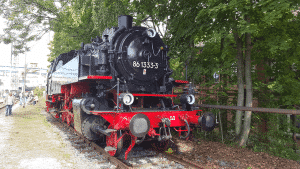The Class 86 hoarded to the unit freight locomotives the German Reichsbahn (DR). The steam locomotive was built in the period 1928-1943 of various preparations, such. MBG Karlsruhe, Linke-Hoffmann-Werke, Friedrich Krupp AG and others. A total of 776 machines were produced. The biggest change in the later series locomotives was finally the renouncement of the Riggenbach backpressure brake. The DRG Class 86 was designed for use on the side limits. She was first inserted in the plains. In addition, after the war was also set for the time being on the low mountain range. Furthermore, in May 1943, the last 86 delivered and stopped the production of 1E steam locomotives 42 and 52 series.
Details of DRG Class 86
| Manufacturer: | BMAG, Borsig, Krupp, Henschel & Sohn, Maschinenfabrik Esslingen, Orenstein & Koppel, Schichau |
| Length: | 13820 mm |
| Numbering: | 86 001-86 591 86 606-86 627 86 698-86 816 86 835-86 875 86 966 Bentheimer Eisenbahn 41 (intended as 86 817) Eutin-Lübecker Eisenbahn 15III (1942 to DR 86 1000) |
| Weight: | 88.5 t |
| Years of construction: | 1928 - 1943 |
| Top speed: | 70-80 km/h |
| Retirement: | 1972 (ÖBB); 1974 (DB); 1976/1989 (DR) |
| Fuel supply: | 4 t hard coal |
| Water supply: | 9.0 m³ |
| Number: | 776 |
| Power: | 758 kW / 1030 PSi |
| Brake: | Single-chamber air brake design Knorr with additional brake |
| Boiler overpressure: | 14 bar |
| Grade: | Gt 46.15 |
| Type: | 1'D1' h2t |
| Interestig facts |
|---|
| The steam locomotive DRG Class 86 belongs to the type 1'D 1' h2. They have 1 running axle independent of the main frame, as well as 4 coupled running axles mounted in the main frame and 1 rear running axle mounted in the main frame. The steam type is superheated steam and the engines have 2 cylinders. More interestig facts |
Fields of application of the DRG Class 86 after the end of the war

At the Deutsche Reichbahn the DRG Class 86 was stationed mainly in the Bw Aue and some in the Bw Heringsdorf. The machines based in the Bw Heringsdorf were equipped with wind deflectors due to the almost constantly blowing crosswinds. In 1973, many locomotives were retired at the German Reich Railway. In May 1988, the DRG class 86 was finally decommissioned. In 1989 there was again a resentment on the trips to the 100th anniversary of the route Schlettau-Crottendorf. The 86 001 was with her 60 years of service, the locomotive with the longest duration of use.
Today there are no more 86 machines in service. There are still 13 locomotives, 9 of which are still in Germany. They are mainly found in museums.
Received DRG Class 86:
»86 001 (SEM Chemnitz) – the oldest machine in this series
»86 049 (VSE Schwarzenberg)
»86 056 (ÖGEG)
»86 240 as Tkt-16 in Poland
»86 283 (DDM Neuenmarkt-Wirsberg)
»86 333 (railway construction and operating company Pressnitztalbahn) – operational
»86 346 (UEF Ettlingen)
»86 348 (GES)
»86 457 (DB Museum)
»86 476 (ÖGEG)
»86 501 (ÖGEG)
»86 607 (VMD loan to Adorf, ÜK)
»86 744 (ÜK, Museum Railway Minden)
